Synology is one of the rapidly rising players in the SMB (Small to Medium Businesses) / SOHO (Small Office & Home Office) NAS market. This market is a highly competitive one with many players like QNAP, Thecus, Netgear, Drobo, LaCie, Seagate and Western Digital. Consumers with a necessity to store and backup their home media collection are also amongst the customers in this market.
Synology has a sensible model number nomenclature in which the last two digits refer to the year through which the model is intended for sale. The first set of digits refer to the maximum number of bays supported. Some models have a + at the end, signifying higher performance. Today, we have the DS211+ for review. The DS refers to the product category, Disk Station. 2 indicates a 2 bay model, and the 11 indicates a 2011 model. It is supposed to have a higher performance compared to the DS211 which was released in November 2010.
Synology has a sensible model number nomenclature in which the last two digits refer to the year through which the model is intended for sale. The first set of digits refer to the maximum number of bays supported. Some models have a + at the end, signifying higher performance. Today, we have the DS211+ for review. The DS refers to the product category, Disk Station. 2 indicates a 2 bay model, and the 11 indicates a 2011 model. It is supposed to have a higher performance compared to the DS211 which was released in November 2010.
The purpose of any NAS is to serve as a centralized repository for data while also having some sort of redundancy built in. The redundancy helps in data recovery, in case of media failure of any other unforeseen circumstances. Along with the standard RAID levels, some companies also offer custom redundancy solutions. The OS on the NAS also varies across vendors.
In addition to manual support for the standard RAID configurations, Synology also provides the SHR (Synology Hybrid Raid) option. The OS on the DS211+ is the Disk Station Manager 3.0 (DSM), a Linux variant. Most of its features for day-to-day operations can be accessed over a web browser.
The last SMB NAS that we reviewed was the LaCie 5big Storage Server, a 5 bay model running Windows Storage Server 2008. We introduced our new NAS benchmarking methodology in that review. In addition to repeating the methodology on the DS211+, we also checked up a little bit on the Linux performance. Before we get to that, however, let us devote a couple of sections to the hardware and software that make up the DS211+.
In addition to manual support for the standard RAID configurations, Synology also provides the SHR (Synology Hybrid Raid) option. The OS on the DS211+ is the Disk Station Manager 3.0 (DSM), a Linux variant. Most of its features for day-to-day operations can be accessed over a web browser.
The last SMB NAS that we reviewed was the LaCie 5big Storage Server, a 5 bay model running Windows Storage Server 2008. We introduced our new NAS benchmarking methodology in that review. In addition to repeating the methodology on the DS211+, we also checked up a little bit on the Linux performance. Before we get to that, however, let us devote a couple of sections to the hardware and software that make up the DS211+.
In the US, Synology sells the NAS with the hard disks bundled and also in a diskless version. The review unit had 2 Seagate 1 TB disks pre-installed. The disks also had the Disk Station Manager (DSM) installed, and so, it was almost pure plug and play.
The contents of the 2 x 1TB DS211+ box are as below:
The contents of the 2 x 1TB DS211+ box are as below:
- Synology DS-211+ chassis
- 2 x 1TB Seagate Barracuda 7200rpm drives inside the chassis
- Cat 5E Ethernet cable
- 72 W external power supply
- CD with Synology Assistant and miscellaneous software / user guides
- Getting Started guide
- Screws for hard disk installation
The DS211+ chassis is aesthetically pleasing, and the drive slots are nicely covered up by the front panel (which is also quite easy to remove). Upon removing the front panel, we can see the two hard drive chassis. The chassis can be pulled out by pressing the button at the top.
The front panel has the status LEDs, a memory card slot, USB 2.0 host port and the power buttons. At the back of the chassis, we have a large, but quiet, fan. There are 2 USB 2.0 host ports, an eSATA host, GbE port and the power adapter input.
Setup was very straightforward. In our testbed, the unit was directly connected to the computer. The Synology Assistant on the supplied CD was installed on the testbed, and it promptly detected the attached unit. Alternatively, one could have just navigated to the IP of the NAS in a browser for the setup / administration process.
The volumes can be setup in any RAID configuration. Synology provides the SHR (Synology Hybrid Raid) option which provides 1-disk redundancy. It has some advantages over the classic RAID with 1-disk redundancy as outlined here. All our benchmarks were run with the volumes managed in SHR configuration.
Setup was very straightforward. In our testbed, the unit was directly connected to the computer. The Synology Assistant on the supplied CD was installed on the testbed, and it promptly detected the attached unit. Alternatively, one could have just navigated to the IP of the NAS in a browser for the setup / administration process.
The volumes can be setup in any RAID configuration. Synology provides the SHR (Synology Hybrid Raid) option which provides 1-disk redundancy. It has some advantages over the classic RAID with 1-disk redundancy as outlined here. All our benchmarks were run with the volumes managed in SHR configuration.
DSM 3.0 is a pleasure to use, and it provides a multitude of management options as shown in the gallery above. There are also options to enable Telnet / SSH into the NAS for the more adventurous users. As is evident from the gallery, many features are targeted towards the home user. These include options to enable the NAS to act as a DLNA DMA and iTunes media server. DSM 3.0 also has apps for Bit Torrent and eMule download management. There is also a surveillance station app to use the NAS as a DVR for a set of IP cameras.
The DS-211+ is not built for an easy teardown (considering that there are no user serviceable parts inside, this is not a surprise). However, we still have photographs of the components laid out bare for analysis.
The DS-211+ runs on the Marvell Kirkwood mv6282 1.6Ghz ARM processor. This processor is beneath the heat sink in the above picture. It has Marvell's own Sheeva core running at 1.6 GHz, though it also has 1.8 and 2.0 GHz variants. The 6282 is a high performance integrated controller (PDF link), with dual GbE MACs and a multitude of SATA / PCI-E / USB 2.0 host and SDIO ports.
The other big chip visible on the main board above is the Marvell 88SX7042, a 4 port SATA to PCI-E x4 bridge. Together with the 2 SATA connections on the 6282, they support the 2 SATA drives and the eSATA port. There are also 2 x8 Hynix DRAM modules making up 512 MB of 16 bit DDR3 SDRAM.
For the purpose of NAS reviews, we have setup a dedicated testbed with the configuration as below. The NAS is directly connected to the testbed (using as many Cat 5E cables as there are ports on the NAS) without a switch or router inbetween. This is done in order to minimize the number of external factors which might influence the performance of the system.
| NAS Benchmarking Testbed Setup | |
| Processor | Intel i5-680 CPU - 3.60GHz, 4MB Cache |
| Motherboard | Asus P7H55D-M EVO |
| OS Hard Drive | Seagate Barracuda XT 2 TB |
| Secondary Drive | Kingston SSDNow 128GB |
| Memory | G.SKILL ECO Series 2GB (1 x 2GB) SDRAM DDR3 1333 (PC3 10666) F3-10666CL7D-4GBECO CAS 7-7-7-21 |
| PCI-E Slot | Quad-Port GbE Intel ESA-I340 |
| Optical Drives | ASUS 8X Blu-ray Drive Model BC-08B1ST |
| Case | Antec VERIS Fusion Remote Max |
| Power Supply | Antec TruePower New TP-550 550W |
| Operating System | Windows 7 Ultimate x64 / Ubuntu 10.04 |
| . | |
In addition to the Realtek GbE NIC on-board the Asus P7H55D-M EVO, four more GbE ports are enabled on the system, thanks to the Intel ESA-I340 quad port GbE ethernet server adapter . With a PCI-E x4 connector, the card was plugged into the PCI-E x16 slot on the Asus motherboard.
Since the Synology DS211+ has only 1 GbE port, there was no need to team the four ports in the ESA-I340.
Intel NASPT is used to benchmark the NAS device. In order to ensure that the hard disk transfer rate is not a bottleneck, NASPT is run from the secondary drive in the testbed (the Kingston SSD). With average read and write speeds of 178.8 MB/s and 167.8 MB/s, it is unlikely that a single GbE link NAS can be limited in performance due to the test system. However, a link aggregated NAS could be affected. Fortunately, as we will see in the next few sections, this wasn't the case for the 5big storage server.
All file copy tests were also performed using the SSD. The file copy test consists of transferring a 10.7 GB Blu-Ray folder structure between the NAS and the testbed using the robocopy command in mirror mode (on Windows) and the rsync -av command (on Linux).
There are three important sharing protocols we investigated in the course of our evaluation of the DS211+. In the next few sections, you will find NASPT and/or robocopy/rsync benchmarking results for Samba, NFS and iSCSI sharing protocols. Each section also has a small description of how the shares were set up on the NAS. The NASPT benchmarks were run in Batch mode thrice, giving us 15 distinct data points. The average of these 15 values is recorded in the graphs presented in the following sections. The robocopy and rsync benchmarks were run thrice, and the average transfer rate of the three iterations is presented alongside the NASPT benchmarks.
In order to get SMB file sharing up and running, it is necessary to set up the Shared Folder and the Win/Mac/NFS settings in the Control Panel. Obviously, this needs to be done after setting up the volume appropriately in the Storage Manager.
The results of running the Intel NASPT benchmarks and our own robocopy tests on the SMB share are given below.
The results of running the Intel NASPT benchmarks and our own robocopy tests on the SMB share are given below.
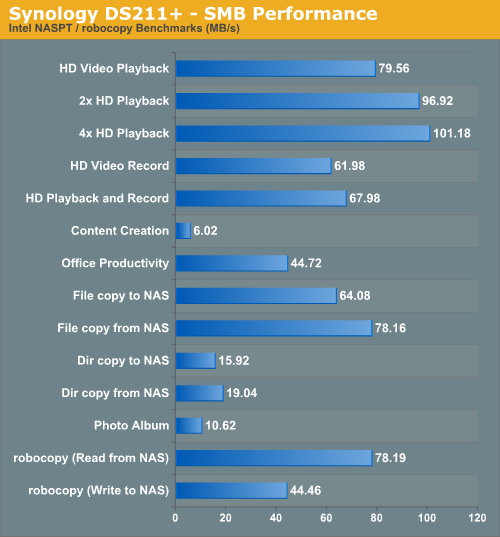
We find that the performance of the unit with respect to media playback workloads surpasses that of the LaCie 5big storage server. This means that the DS211+ is much more suited for usage as a media server in the home environment. It is important to note that the LaCie unit has dual GbE ports and is supposed to be much more powerful. SMB and SOHO users would be happy to note that the performance of the DS211+ in this case is almost as good as the LaCie unit, at a fraction of its cost. Synology also provides a host of features targeted towards Windows users (Active Directory support etc.).
Many SMB / SOHO users also run NAS systems with iSCSI targets. The iSCSI target option is one of the hyped features of the Windows Storage Server OS. However, the iSCSI target option is also provided by other NAS vendors such as Synology, QNAP and Thecus.
The iSCSI target needs to be setup in the Storage Manager section. Appropriate CHAP credentials can also be setup, though we didn't use CHAP authentication in our testbed.
The results of running the Intel NASPT benchmarks and our own robocopy tests on the iSCSI target are given below.
The iSCSI target needs to be setup in the Storage Manager section. Appropriate CHAP credentials can also be setup, though we didn't use CHAP authentication in our testbed.
The results of running the Intel NASPT benchmarks and our own robocopy tests on the iSCSI target are given below.
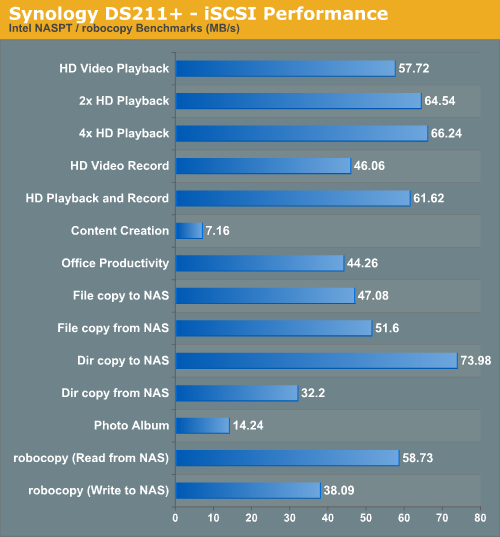
Writes to iSCSI targets are faster than the LaCie 5big server, but reads are slower. Also, SMB performance is better in more workloads than in iSCSI. If you are using iSCSI targets, the reason is probably because SMB shares are not going to work out in your situation.
Any shared folder on the NAS can be set up for NFS sharing. It is just a small matter of setting up the NFS privileges for the shared folder. One needs to remember to check the NFS sharing service option in the Win/Mac/NFS Control Panel settings.
The NFS shares were quite easy to set up and access from other Linux based machines / media streamers. However, accessing them from Windows was not quite straightforward as it was with the LaCie 5big Storage Server.
For the benchmark in this section, we booted our testbed into Ubuntu and replicated our robocopy command with rsync. In the first run, we set up a SMB share and write and read the same contents used in robocopy using rsync. The second set of tests were run after setting up a NFS share and removing the Windows File Sharing option to remove the SMB shares.
The NFS shares were quite easy to set up and access from other Linux based machines / media streamers. However, accessing them from Windows was not quite straightforward as it was with the LaCie 5big Storage Server.
For the benchmark in this section, we booted our testbed into Ubuntu and replicated our robocopy command with rsync. In the first run, we set up a SMB share and write and read the same contents used in robocopy using rsync. The second set of tests were run after setting up a NFS share and removing the Windows File Sharing option to remove the SMB shares.
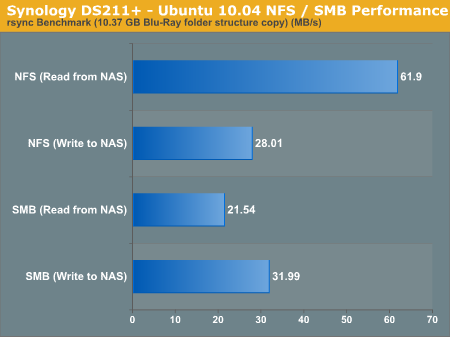
SMB performance on Ubuntu 11.04 is pretty bad compared to what was obtained with Windows 7. NFS - Linux performance is also not as good as SMB - Windows performance.
We have taken a brief look at the performance of the Synology DS211+. The NAS has plenty of features which we have not explored in detail in this review.
Does the performance of the NAS live up to what is claimed by Synology? We do have to agree with them. This is one of those rare products which don't leave much to complain about. If we have to nitpick, we could ask Synology to improve NFS performance, and not concentrate on SMB alone.
A diskless version of the DS211+ can be purchased for $410 if you shop around. This is as much as what the Atom based dual GbE sporting ReadyNAS Ultra 2 bay model (RNDU2000) costs. Pricing is something Synology has to work on.
An option to make the unit act as a DAS (Direct Attached Storage) would also be nice. This, however, is again not the way the industry is moving forward. Some of the Drobo models act as both DAS and NAS. However, even Drobo is dropping the DAS feature in favour of pure NAS only options in their recent models.
Users with a large media collection may opt for the DS1511+. This 5 bay model can also link to 2 more 5 bay models, giving a total of 15 bays of RAID storage. The DS1511+ has already received praise from many users in AVSForums.
The DS211+ is also quite power efficient and silent. At full load, the unit consumed 25.6 W. In sleep mode (from which it is woken up if there is any access to the disks over the network), it consumes 12.1 W. This is far less than what Atom based NAS models consume. The DS211+ is rated to have a noise level of less than 20 dB according to official specifications. It looks as if Atom based models are an overkill for home media NAS. Users are better off with the Marvell based NAS platforms in such a scenario.
Synology support is also pretty highly rated amongst users, and they have webinars and a detailed wiki to help users make the most of their NAS. All in all, the DS211+ is a power efficient and high performance unit. You wouldn't do much wrong in opting for it, if you are in the market for a 2 bay NAS.
Does the performance of the NAS live up to what is claimed by Synology? We do have to agree with them. This is one of those rare products which don't leave much to complain about. If we have to nitpick, we could ask Synology to improve NFS performance, and not concentrate on SMB alone.
A diskless version of the DS211+ can be purchased for $410 if you shop around. This is as much as what the Atom based dual GbE sporting ReadyNAS Ultra 2 bay model (RNDU2000) costs. Pricing is something Synology has to work on.
An option to make the unit act as a DAS (Direct Attached Storage) would also be nice. This, however, is again not the way the industry is moving forward. Some of the Drobo models act as both DAS and NAS. However, even Drobo is dropping the DAS feature in favour of pure NAS only options in their recent models.
Users with a large media collection may opt for the DS1511+. This 5 bay model can also link to 2 more 5 bay models, giving a total of 15 bays of RAID storage. The DS1511+ has already received praise from many users in AVSForums.
The DS211+ is also quite power efficient and silent. At full load, the unit consumed 25.6 W. In sleep mode (from which it is woken up if there is any access to the disks over the network), it consumes 12.1 W. This is far less than what Atom based NAS models consume. The DS211+ is rated to have a noise level of less than 20 dB according to official specifications. It looks as if Atom based models are an overkill for home media NAS. Users are better off with the Marvell based NAS platforms in such a scenario.
Synology support is also pretty highly rated amongst users, and they have webinars and a detailed wiki to help users make the most of their NAS. All in all, the DS211+ is a power efficient and high performance unit. You wouldn't do much wrong in opting for it, if you are in the market for a 2 bay NAS.
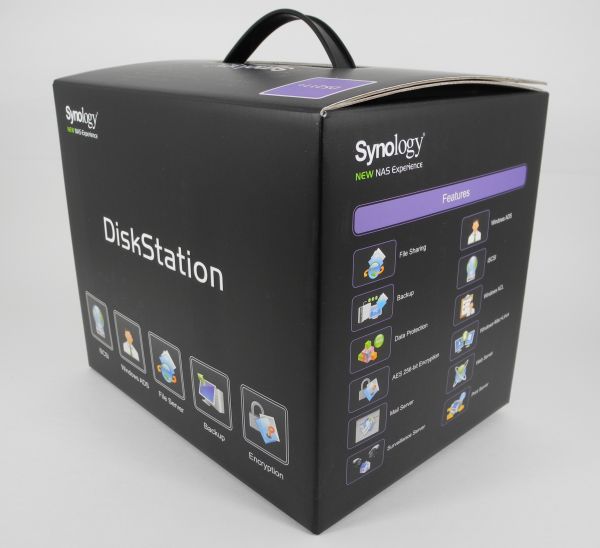





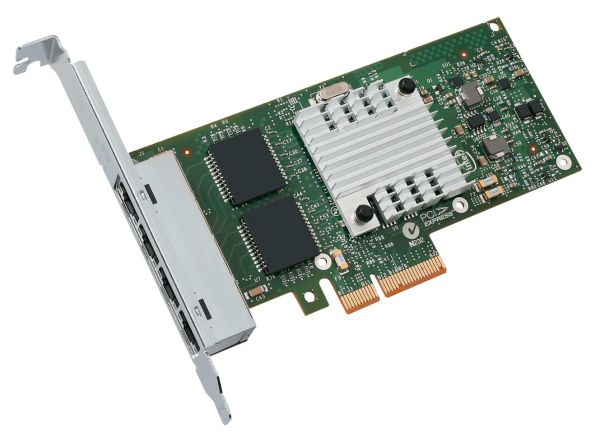
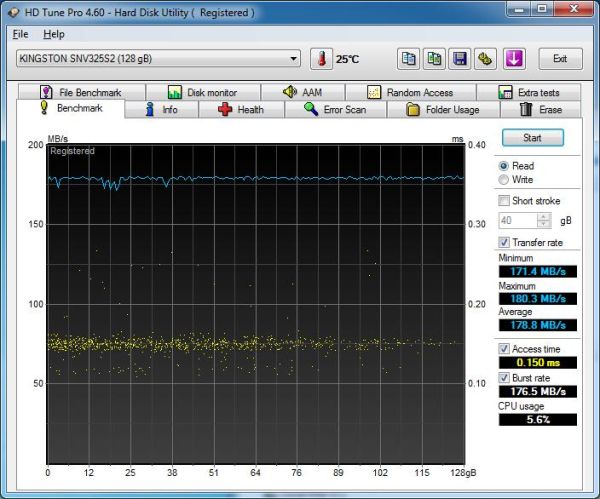

0 comments:
Post a Comment